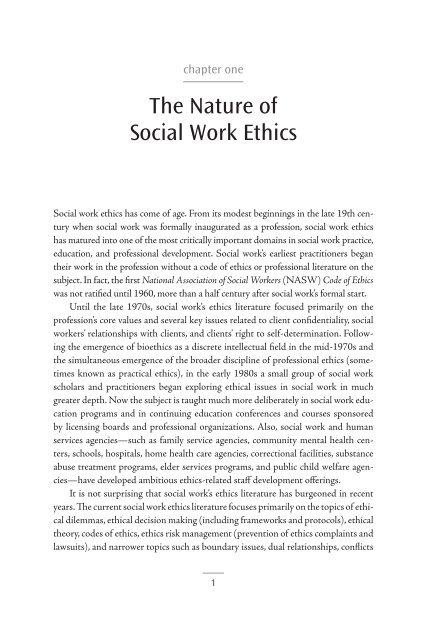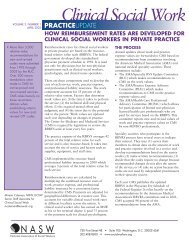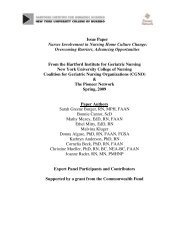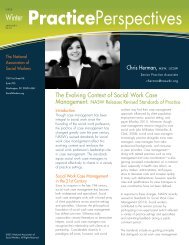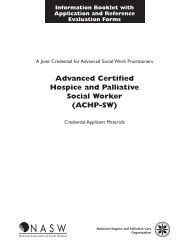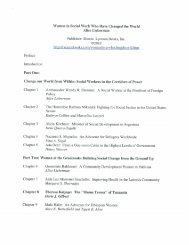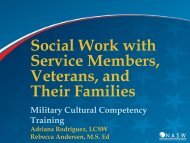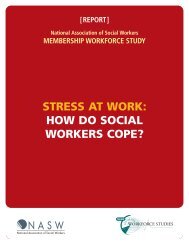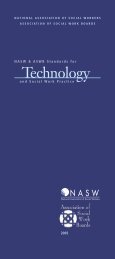The Nature of Social Work Ethics - National Association of Social ...
The Nature of Social Work Ethics - National Association of Social ...
The Nature of Social Work Ethics - National Association of Social ...
You also want an ePaper? Increase the reach of your titles
YUMPU automatically turns print PDFs into web optimized ePapers that Google loves.
chapter one<strong>The</strong> <strong>Nature</strong> <strong>of</strong><strong>Social</strong> <strong>Work</strong> <strong>Ethics</strong><strong>Social</strong> work ethics has come <strong>of</strong> age. From its modest beginnings in the late 19th centurywhen social work was formally inaugurated as a pr<strong>of</strong>ession, social work ethicshas matured into one <strong>of</strong> the most critically important domains in social work practice,education, and pr<strong>of</strong>essional development. <strong>Social</strong> work’s earliest practitioners begantheir work in the pr<strong>of</strong>ession without a code <strong>of</strong> ethics or pr<strong>of</strong>essional literature on thesubject. In fact, the first <strong>National</strong> <strong>Association</strong> <strong>of</strong> <strong>Social</strong> <strong>Work</strong>ers (NASW) Code <strong>of</strong> <strong>Ethics</strong>was not ratified until 1960, more than a half century after social work’s formal start.Until the late 1970s, social work’s ethics literature focused primarily on thepr<strong>of</strong>ession’s core values and several key issues related to client confidentiality, socialworkers’ relationships with clients, and clients’ right to self-determination. Followingthe emergence <strong>of</strong> bioethics as a discrete intellectual field in the mid-1970s andthe simultaneous emergence <strong>of</strong> the broader discipline <strong>of</strong> pr<strong>of</strong>essional ethics (sometimesknown as practical ethics), in the early 1980s a small group <strong>of</strong> social workscholars and practitioners began exploring ethical issues in social work in muchgreater depth. Now the subject is taught much more deliberately in social work educationprograms and in continuing education conferences and courses sponsoredby licensing boards and pr<strong>of</strong>essional organizations. Also, social work and humanservices agencies—such as family service agencies, community mental health centers,schools, hospitals, home health care agencies, correctional facilities, substanceabuse treatment programs, elder services programs, and public child welfare agencies—havedeveloped ambitious ethics-related staff development <strong>of</strong>ferings.It is not surprising that social work’s ethics literature has burgeoned in recentyears. <strong>The</strong> current social work ethics literature focuses primarily on the topics <strong>of</strong> ethicaldilemmas, ethical decision making (including frameworks and protocols), ethicaltheory, codes <strong>of</strong> ethics, ethics risk management (prevention <strong>of</strong> ethics complaints andlawsuits), and narrower topics such as boundary issues, dual relationships, conflicts1
<strong>The</strong> <strong>Social</strong> <strong>Work</strong> <strong>Ethics</strong> Casebook<strong>of</strong> interest, informed consent, confidentiality and privileged communication, pr<strong>of</strong>essionalpaternalism, ethics committees, ethics consultation, organizational ethics,ethics and managed care, and impaired practitioners.Over time, social workers concerned about ethics education have discovered thatcase studies are compelling and essential. <strong>Social</strong> workers live their pr<strong>of</strong>essional liveswrestling with complex case-related challenges. When is it appropriate to violate a client’sright to confidentiality to protect a third party from harm? Under what circumstancesis it ethical to interfere with a client’s right to self-determination to protect theclient from self-harm? What is the ethical way to resolve a potential conflict <strong>of</strong> interestwhen a qualified former client applies for a job at the social worker’s agency and maybecome a colleague? How should a social worker act when she or he discovers that avalued colleague has behaved unethically? Is it ever permissible to deceive clients, evenif it is “for their own good”? How should a social work administrator allocate limitedagency resources when budget cuts impair her or his ability to meet clients’ needs?Case material brings ethics theories and concepts to life. Clearly, theories andconcepts are important. <strong>The</strong>y provide the conceptual guidance that pr<strong>of</strong>essionalsneed to frame their assessments, program planning, interventions, and evaluations.But, theories and concepts by themselves can be sterile when presented in a vacuum.Wrapping theories and concepts around actual case material enriches social workers’understanding and insights. Cases provide a valuable lens through which to viewand apply important theories and concepts.This book includes a broad cross-section <strong>of</strong> ethics cases related to every coreaspect <strong>of</strong> social work: clinical practice with individuals, families, couples, and smallgroups; community practice; policy practice; social justice and advocacy; administrationand management; and research and evaluation. To fully appreciate the implicationsand relevance <strong>of</strong> ethics cases, it is important to understand the ways in whichethical standards and conceptual frameworks in social work have evolved. Muchcontemporary thinking on social work ethics resembles earlier perspectives; however,as we shall see, on other issues social workers’ ethics-related perspectives havechanged significantly over time. This shifting context provides a useful backdrop tothe cases presented in this book.<strong>The</strong> Evolution <strong>of</strong> <strong>Social</strong> <strong>Work</strong> <strong>Ethics</strong><strong>Social</strong> work’s concern with ethics spans four major, sometimes overlapping, periods:the morality period, the values period, the ethical theory and decision-makingperiod, and the ethical standards and risk management period.2
<strong>The</strong> <strong>Nature</strong> <strong>of</strong> <strong>Social</strong> <strong>Work</strong> <strong>Ethics</strong>THE MORALITY PERIOD. In the late 19th century, when social work was formallyinaugurated as a pr<strong>of</strong>ession, there was much more concern about the morality <strong>of</strong> theclient than about the morality or ethics <strong>of</strong> the pr<strong>of</strong>ession or its practitioners. <strong>Social</strong>workers’ earliest practitioners focused on organized relief for people living in povertyand other vulnerable circumstances. Often this preoccupation took the form <strong>of</strong>paternalistic efforts to bolster poor people’s morality and the rectitude <strong>of</strong> those whohad succumbed to “shiftless” or “wayward” habits.<strong>Social</strong> workers’ focus on the morality <strong>of</strong> poor people waned significantly duringthe settlement house movement in the early 20th century, when many socialworkers turned their attention to structural and environmental causes <strong>of</strong> individualand social problems, particularly social workers’ ethical obligation to promote socialjustice and social reform. As has been well documented in the pr<strong>of</strong>ession’s literature,many social workers were concerned with “cause” rather than, or in addition to,“case.” This was evident in social workers’ social reform efforts designed to addressthe toxic environmental determinants <strong>of</strong> problems related to poverty, inadequatehousing and health care, mental illness, alcoholism, and violence.Emphasis on clients’ morality continued to weaken during the next severaldecades as social workers created and refined various intervention theories andstrategies, training programs, and educational models. During this phase, manysocial workers were more concerned about cultivating perspectives and methodsthat would be indigenous to social work, partly in an effort to distinguish socialwork’s approach to helping from those <strong>of</strong> allied pr<strong>of</strong>essions, such as psychology andpsychiatry.THE VALUES PERIOD. Although a critical mass <strong>of</strong> serious scholarship on socialwork ethics did not appear until the 1950s, there were several efforts earlier in the20th century to explore social work values and ethics. As early as 1919 there wereattempts to draft pr<strong>of</strong>essional codes <strong>of</strong> ethics. In 1922 the Family Welfare <strong>Association</strong><strong>of</strong> America appointed an ethics committee in response to questions about ethicalproblems in social work. In addition, there is evidence that at least some schools<strong>of</strong> social work were teaching discrete courses on values and ethics in the 1920s.By the late 1940s and early 1950s, social workers’ concern about the moraldimensions <strong>of</strong> the pr<strong>of</strong>ession shifted. Instead <strong>of</strong> the earlier preoccupation with clients’morality, social workers began to focus much more on the morality, values, andethics <strong>of</strong> the pr<strong>of</strong>ession and its practitioners. Nearly a half century after its formalbeginning, social work began to develop and publicize ethical standards and guidelines.In 1947, after several years <strong>of</strong> discussion and debate, the Delegate Conference<strong>of</strong> the American <strong>Association</strong> <strong>of</strong> <strong>Social</strong> <strong>Work</strong>ers adopted a code <strong>of</strong> ethics. Several3
<strong>The</strong> <strong>Social</strong> <strong>Work</strong> <strong>Ethics</strong> Casebooksocial work journals also published several seminal articles on values and ethics. In1959 Muriel Pumphrey published her landmark work, <strong>The</strong> Teaching <strong>of</strong> Values and<strong>Ethics</strong> in <strong>Social</strong> <strong>Work</strong> Education, for the Council on <strong>Social</strong> <strong>Work</strong> Education.In the 1960s and early 1970s, social workers directed considerable attentiontoward matters <strong>of</strong> social justice, social reform, and civil rights. <strong>The</strong> social turbulence<strong>of</strong> this era had enormous influence on the pr<strong>of</strong>ession. Thousands <strong>of</strong> new practitionerswere attracted to the pr<strong>of</strong>ession primarily because <strong>of</strong> social work’s abiding concernabout values germane to human rights, welfare rights, equality, discrimination,and oppression. It is significant that NASW adopted its first code <strong>of</strong> ethics duringthis period.Particularly important during this period was the proliferation <strong>of</strong> commentaryon core social work values. <strong>The</strong>se discussions <strong>of</strong> social work values were <strong>of</strong> threetypes. One group included broad descriptive overviews <strong>of</strong> the pr<strong>of</strong>ession’s missionand its core values, such as respect <strong>of</strong> people, valuing individuals’ capacity for change,client self-determination, client empowerment, individual worth and dignity, commitmentto social change and social justice, service to others, pr<strong>of</strong>essional competence,pr<strong>of</strong>essional integrity, providing individuals with opportunity to realize theirpotential, seeking to meet individuals’ common human needs, client privacy andconfidentiality, nondiscrimination, equal opportunity, respect <strong>of</strong> diversity, and willingnessto transmit pr<strong>of</strong>essional knowledge and skills to others. A second group <strong>of</strong>discussions included critiques <strong>of</strong> social work values. Finally, a third group <strong>of</strong> discussionsincluded reports <strong>of</strong> empirical research on values held or embraced by socialworkers.During this period many social workers focused on the need for social workersto examine and clarify their own personal values. <strong>The</strong> premise here was that socialworkers’ personal beliefs and values related, for example, to people living in poverty,race relations, abortion, homosexuality, civil disobedience, and drug use would havea pr<strong>of</strong>ound effect on their approach to and relationships with clients.THE ETHICAL THEORY AND DECISION-MAKING PERIOD. <strong>Social</strong> work entered a new phasein the early 1980s, influenced largely by the invention in the 1970s <strong>of</strong> a new fieldknown as applied and pr<strong>of</strong>essional ethics (sometimes known as practical ethics).<strong>The</strong> principal feature <strong>of</strong> the applied and pr<strong>of</strong>essional ethics field, which began especiallywith developments in medical ethics, or what has become known as bioethics,was the deliberate, disciplined attempt to apply principles, concepts, and theories<strong>of</strong> moral philosophy, or ethics, to real-life challenges faced by pr<strong>of</strong>essionals. Fordecades prior to this development, moral philosophers had been preoccupied withfairly abstract debates about the meaning <strong>of</strong> ethical terms and the validity <strong>of</strong> rather4
<strong>The</strong> <strong>Nature</strong> <strong>of</strong> <strong>Social</strong> <strong>Work</strong> <strong>Ethics</strong>abstruse ethical theories and conceptually complex moral arguments, a philosophicalspecialty known as meta-ethics. Several factors, however, inspired a substantialcontingent <strong>of</strong> moral philosophers to turn their attention to more practical andimmediate ethical problems. First, intense social debate in the 1960s concerningsuch prominent issues as welfare rights, prisoners’ rights, patients’ rights, women’srights, human rights, and affirmative action led many moral philosophers to grapplewith contemporary issues. Second, a number <strong>of</strong> technological developments, particularlyrelated to health care issues (for example, reproduction, organ transplantation,abortion, and end-<strong>of</strong>-life decisions), led many moral philosophers to exploreapplied ethical issues. In addition, increasingly widespread media publicity relatedto moral scandals and ethical misconduct in public and pr<strong>of</strong>essional life, beginningespecially with Watergate in the early 1970s, stirred up interest in pr<strong>of</strong>essional ethics.It was during this period that now-prominent ethics organizations got theirformal start, most notably the Hastings Center and the Kennedy Institute <strong>of</strong> <strong>Ethics</strong>at Georgetown University. (<strong>The</strong> number <strong>of</strong> applied and pr<strong>of</strong>essional ethics organizationshas grown so large that there is now a national <strong>Association</strong> for Practical andPr<strong>of</strong>essional <strong>Ethics</strong>.)Along with most other pr<strong>of</strong>essions—including nursing, medicine, journalism,engineering, dentistry, law, psychology, counseling, and business—social work’s literatureon ethics began to change significantly in the early 1980s. In addition todiscussions about the pr<strong>of</strong>ession’s values, a small group <strong>of</strong> scholars began to writeabout ethical issues and challenges while drawing on literature, concepts, theories,and principles from the traditional field <strong>of</strong> moral philosophy and the newer field<strong>of</strong> applied and pr<strong>of</strong>essional ethics. Using somewhat different approaches, severalsocial workers acknowledged explicitly for the first time the relevance <strong>of</strong> moralphilosophy and ethical theory, concepts, and principles in the analysis and resolution<strong>of</strong> ethical issues in social work. Furthermore, the 1987 edition <strong>of</strong> the NASWEncyclopedia <strong>of</strong> <strong>Social</strong> <strong>Work</strong> included an article directly addressing the relevance <strong>of</strong>philosophical and ethical concepts to social work ethics.Since the early and mid-1980s, literature on social work ethics that drawsdirectly on ethical theory and concepts has burgeoned. Most <strong>of</strong> this literatureexplores the relationship between standard ethical theories (known as deontology,teleology, consequentialism, utilitarianism, and virtue theory) and actual or hypotheticalethical dilemmas encountered by social workers. Relevant ethical dilemmasconcern direct practice and clinical practice (for example, confidentiality, client selfdetermination,informed consent, pr<strong>of</strong>essional paternalism, truth telling, conflicts<strong>of</strong> interest), program design and agency administration (for example, adhering to5
<strong>The</strong> <strong>Social</strong> <strong>Work</strong> <strong>Ethics</strong> Casebookagency policies or regulations and distributing limited resources), and relationshipsamong practitioners (for example, reporting colleagues’ unethical behavior orimpairment). Examples include social workers who must decide between their dutyto respect the client’s rights to confidentiality and their obligation to protect thirdparties from harm; whether to place limits on the client’s right to engage in selfdestructivebehavior; how to allocate scarce or limited resources; whether to complywith an allegedly unjust law or regulation; and whether to “blow the whistle” andreport a pr<strong>of</strong>essional colleague’s ethical misconduct to authorities.A significant portion <strong>of</strong> the literature since the mid-1980s has focused on decision-makingstrategies social workers can engage in when faced with difficult ethicaljudgments. Typically, these discussions identify a series <strong>of</strong> steps and considerationssocial workers can follow as they attempt to resolve difficult ethical dilemmas, focusingon the conflicting values, ethical duties, and obligations; the individuals, groups,and organizations that are likely to be affected; possible courses <strong>of</strong> action; relevantethical theories, principles, and guidelines; legal principles and pertinent codes <strong>of</strong>ethics; social work practice theory and principles; personal values; the need to consultwith colleagues and appropriate experts; and the need to monitor, evaluate, anddocument decisions.ETHICAL STANDARDS AND RISK MANAGEMENT PERIOD. <strong>The</strong> most recent stage reflectsthe remarkable growth in social workers’ understanding <strong>of</strong> ethical issues in the pr<strong>of</strong>ession.It is marked primarily by the 1996 ratification <strong>of</strong> the NASW Code <strong>of</strong> <strong>Ethics</strong>,which significantly expanded ethical guidelines and standards for social workpractice.As I noted earlier, few formal ethical standards existed early in social work’shistory. <strong>The</strong> earliest known attempt to formulate a code was an experimental draftcode <strong>of</strong> ethics attributed to Mary Richmond. Although several other social workorganizations developed draft codes during social work’s early years (for example,the American <strong>Association</strong> for Organizing Family <strong>Social</strong> <strong>Work</strong> and several chapters<strong>of</strong> the American <strong>Association</strong> <strong>of</strong> <strong>Social</strong> <strong>Work</strong>ers), it was not until 1947 that the lattergroup adopted a formal code. In 1960 NASW adopted its first code <strong>of</strong> ethics, fiveyears after the association was formed.Codes <strong>of</strong> <strong>Ethics</strong><strong>The</strong> 1960 NASW Code <strong>of</strong> <strong>Ethics</strong> consisted <strong>of</strong> only 14 proclamations concerning,for example, every social worker’s duty to give precedence to pr<strong>of</strong>essional responsibilityover personal interests; to respect the privacy <strong>of</strong> clients; to give appropriate6
<strong>The</strong> <strong>Nature</strong> <strong>of</strong> <strong>Social</strong> <strong>Work</strong> <strong>Ethics</strong>pr<strong>of</strong>essional service in public emergencies; and to contribute knowledge, skills, andsupport to human welfare programs. A series <strong>of</strong> brief first-person statements (suchas, “I give precedence to my pr<strong>of</strong>essional responsibility over my personal interests,”and, “I respect the privacy <strong>of</strong> the people I serve,” [p. 1]) were preceded by a preamblethat set forth social workers’ responsibilities to uphold humanitarian ideals, maintainand improve social work service, and develop the philosophy and skills <strong>of</strong> thepr<strong>of</strong>ession. In 1967 a 15th principle pledging nondiscrimination was added to theproclamations.In 1977, based in part on growing concern about this code’s level <strong>of</strong> abstractionand usefulness, NASW established a task force chaired by Charles Levy torevise the code. In 1979 NASW adopted a new code, which was far more ambitiousthan the 1960 code. <strong>The</strong> 1979 code included nearly 80 ethical “principles” dividedinto six major sections <strong>of</strong> brief, unannotated statements with a preamble describingthe code’s general purpose and stating that the code’s principles provided guidelinesfor the enforcement <strong>of</strong> ethical practices in the pr<strong>of</strong>ession. <strong>The</strong> code included majorsections concerning social workers’ general conduct and comportment and ethicalresponsibilities to clients, colleagues, employers, employing organizations, the socialwork pr<strong>of</strong>ession, and society.<strong>The</strong> 1979 code was revised twice (NASW, 1990, 1993) as a result <strong>of</strong> severalimportant developments. In 1990 several principles related to solicitation <strong>of</strong> clientsand fee splitting were modified following an inquiry, begun in 1986, into NASWpolicies by the U.S. Federal Trade Commission (FTC). <strong>The</strong> FTC alleged that thecode’s prohibition <strong>of</strong> client solicitation and fee splitting constituted an inappropriaterestraint <strong>of</strong> trade. As a result <strong>of</strong> the inquiry, principles in the code were revised toremove prohibitions concerning solicitation <strong>of</strong> clients from colleagues or one’s agencyand to modify wording related to accepting compensation for making a referral.In 1992 an NASW task force, which I chaired, recommended that five specificnew principles addressing two new concepts be added to the code. Three <strong>of</strong> theprinciples concerned the problem <strong>of</strong> social worker impairment, and two concernedthe problem <strong>of</strong> dual or multiple relationships between social workers and clients.Both the problem <strong>of</strong> social worker impairment and dual and multiple relationshipsbetween social workers and clients had begun to receive increasing attention in thepr<strong>of</strong>ession and, the task force argued, needed to be acknowledged in the code. In1993 the NASW Delegate Assembly voted to add these five new principles.By the time <strong>of</strong> the 1993 NASW Delegate Assembly, there was growing awarenessamong social workers that the NASW Code <strong>of</strong> <strong>Ethics</strong> required significantrevision and that modest changes and “tinkering” would no longer suffice. <strong>The</strong> vast7
<strong>The</strong> <strong>Social</strong> <strong>Work</strong> <strong>Ethics</strong> Casebookmajority <strong>of</strong> the scholarly literature on social work ethics had been published sincethe ratification <strong>of</strong> the 1979 code, which went into effect as the broader field <strong>of</strong>applied and pr<strong>of</strong>essional ethics was in its infancy. <strong>The</strong>re was widespread recognitionthat issues explored in social work, not to mention the broader applied and pr<strong>of</strong>essionalethics field, since the ratification <strong>of</strong> the 1979 code needed to be reflected ina new code. Examples included new knowledge and discussions related to ethicalmisconduct, ethical decision making, informed consent, dual and multiple relationshipsand related boundary issues, confidentiality and the protection <strong>of</strong> third parties,privileged communication, electronic communications, ethical issues in socialwork supervision, ethics consultation, ethical issues in industrial social work, theteaching <strong>of</strong> social work ethics, ethics and unionization, ethical issues in organizations,impaired social workers, ethics in social work research and evaluation, pr<strong>of</strong>essionalpaternalism, bioethical issues in social work, ethics committees, pr<strong>of</strong>essionalmalpractice, and social work’s moral mission.Because <strong>of</strong> the exponential growth <strong>of</strong> ethics-related knowledge—with respectto social work in particular and the pr<strong>of</strong>essions in general—since the development<strong>of</strong> the 1979 code, delegates at the 1993 NASW Delegate Assembly recognized theneed for an entirely new code. In addition, there was widespread recognition that thepr<strong>of</strong>ession’s code needed to pay more attention to ethical issues facing social workersnot involved in direct practice and clinical practice, especially social workers involvedin agency administration, supervision, research and evaluation, and education. Thus,the Delegate Assembly passed a resolution to establish a task force to draft a completelynew code <strong>of</strong> ethics for submission to the 1996 Delegate Assembly. <strong>The</strong> taskforce was established to produce a new code that would be far more comprehensiveand relevant to current practice, taking into consideration the tremendous increasein knowledge since the ratification <strong>of</strong> the 1979 code.<strong>The</strong> Code <strong>of</strong> <strong>Ethics</strong> Revision Committee was appointed in 1994 by the president<strong>of</strong> NASW and spent two years drafting a new code designed to incorporate comprehensiveguidelines reflecting the impressive expansion <strong>of</strong> knowledge in the field. <strong>The</strong>committee, which I chaired, included a moral philosopher active in the pr<strong>of</strong>essionalethics field and social workers from a variety <strong>of</strong> practice and academic settings. 1During the two-year period leading up to the final draft <strong>of</strong> the new code, the committeereviewed literature on social work ethics and on applied and pr<strong>of</strong>essional1. Members <strong>of</strong> the committee included Carol Brill, Jacqueline Glover, Marjorie Hammock, M.Vincentia Joseph, Alfred Murillo, Jr., Frederic Reamer [chair], Barbara Varley, and Drayton Vincent.8
<strong>The</strong> <strong>Nature</strong> <strong>of</strong> <strong>Social</strong> <strong>Work</strong> <strong>Ethics</strong>ethics generally to identify key concepts and issues that might be addressed in thenew code, reviewed the 1979 code (as revised) to identify content that should beretained or deleted and areas where content might be added, issued formal invitationsto all NASW members and to members <strong>of</strong> various social work organizations(the <strong>National</strong> <strong>Association</strong> <strong>of</strong> Black <strong>Social</strong> <strong>Work</strong>ers, the Council on <strong>Social</strong> <strong>Work</strong>Education, the American <strong>Association</strong> <strong>of</strong> State <strong>Social</strong> <strong>Work</strong> Boards, and the <strong>National</strong>Federation <strong>of</strong> Societies <strong>of</strong> Clinical <strong>Social</strong> <strong>Work</strong>) to suggest issues that might beaddressed in the new code, shared rough drafts <strong>of</strong> the code with a small group <strong>of</strong>ethics experts in social work and other pr<strong>of</strong>essions for their comments, and revisedthe code on the basis <strong>of</strong> the various sources <strong>of</strong> feedback. <strong>The</strong> draft code was publishedin the NASW News, along with an invitation for all NASW members to submitcomments to be considered by the committee as it prepared the final draft forsubmission to the 1996 Delegate Assembly. Committee members also met witheach <strong>of</strong> the NASW Delegate Assembly regional coalitions to discuss the code’sdevelopment and content and to receive delegates’ comments and feedback. <strong>The</strong>code was then presented to and overwhelmingly ratified by the Delegate Assembly.<strong>The</strong> current code, which is clearly the most comprehensive set <strong>of</strong> ethical standardsin social work, reflects the state <strong>of</strong> the art in social work ethics (see Appendix).<strong>The</strong> code’s preamble signifies a remarkable event in social work’s history. For thefirst time in NASW’s history, the code <strong>of</strong> ethics includes a formally sanctioned missionstatement and an explicit summary <strong>of</strong> the pr<strong>of</strong>ession’s core values. <strong>The</strong> Code <strong>of</strong><strong>Ethics</strong> Revision Committee felt strongly that the pr<strong>of</strong>ession’s code should includea forceful statement <strong>of</strong> social work’s moral aims, drawing on the pr<strong>of</strong>ession’s timehonoredcommitments and contemporary concerns. <strong>The</strong> mission statement emphasizessocial work’s historic and enduring commitment to enhancing well-being andhelping meet the basic needs <strong>of</strong> all people (Towle, 1965), with particular attentionto the needs and empowerment <strong>of</strong> people who are vulnerable, oppressed, and livingin poverty. <strong>The</strong> mission statement stresses social work’s venerated concern aboutvulnerable populations and the pr<strong>of</strong>ession’s traditional simultaneous focus on individualwell-being and the environmental forces that create, contribute to, and addressproblems in living. <strong>The</strong> preamble also emphasizes social workers’ determination topromote social justice and social change with and on behalf <strong>of</strong> clients.A particularly noteworthy feature <strong>of</strong> the preamble is the inclusion <strong>of</strong> six corevalues on which social work’s mission is based: service, social justice, dignity andworth <strong>of</strong> the person, importance <strong>of</strong> human relationships, integrity, and competence.<strong>The</strong> Code <strong>of</strong> <strong>Ethics</strong> Revision Committee settled on these core values after engagingin a systematic and comprehensive review <strong>of</strong> literature on the subject.9
<strong>The</strong> <strong>Social</strong> <strong>Work</strong> <strong>Ethics</strong> Casebook<strong>The</strong> code also provides a brief guide for dealing with ethical issues or dilemmasin social work practice. Drawing on literature on ethical decision making insocial work, this section highlights various resources social workers should considerwhen they encounter challenging ethical decisions, including ethical theory, literatureon ethical decision-making strategies, social work practice theory and research,relevant laws and regulations, agency policies, and other relevant codes <strong>of</strong> ethics.<strong>Social</strong> workers are also encouraged to obtain ethics consultation when appropriate,perhaps from an agency-based or social work organization’s ethics committee,regulatory bodies (for example, a state licensing board), knowledgeable colleagues,supervisors, or legal counsel.<strong>The</strong> code’s most extensive section, “Ethical Standards,” greatly expands the number<strong>of</strong> specific ethical guidelines contained in the code, again reflecting increasedknowledge in the pr<strong>of</strong>ession. <strong>The</strong> 155 specific ethical standards are designed toguide social workers’ conduct, reduce malpractice and liability risks, and providea basis for adjudication <strong>of</strong> ethics complaints filed against NASW members (thestandards are also used by other bodies that have chosen to adopt the code, suchas state licensing and regulatory boards, pr<strong>of</strong>essional liability insurance providers,courts <strong>of</strong> law, agency boards <strong>of</strong> directors, and government agencies). In general, thecode’s standards concern three kinds <strong>of</strong> issues: (1) what are usually considered to be“mistakes” social workers might make that have ethical implications (for example,mentioning clients’ names in public or semipublic areas, forgetting to renew a client’sexpired release <strong>of</strong> information form before disclosing sensitive documents toa third party, or overlooking an important agency policy concerning termination <strong>of</strong>services), (2) difficult ethical decisions faced by social workers that have reasonablearguments for and against different courses <strong>of</strong> action (for example, decisions aboutwhether to disclose confidential information to protect a third party, how to allocatescarce or limited agency resources, whether to honor a picket line at one’s employmentsetting, whether to obey an unjust law or regulation, or whether to interferewith a client who willingly is engaging in self-destructive behavior), and (3) ethicalmisconduct (for example, sexual exploitation <strong>of</strong> clients, conflicts <strong>of</strong> interest, deliberatemisrepresentation, or fraudulent activity).<strong>The</strong> code’s standards fall into six substantive categories concerning social workers’ethical responsibilities to clients, to colleagues, in practice settings, as pr<strong>of</strong>essionals,to the pr<strong>of</strong>ession, and to society at large. <strong>The</strong> first section, Ethical Responsibilitiesto Clients, is the most detailed and comprehensive because it addressesa wide range <strong>of</strong> issues involved in the delivery <strong>of</strong> services to individuals, families,couples, and small groups <strong>of</strong> clients. In addition to more detailed standards on10
<strong>The</strong> <strong>Nature</strong> <strong>of</strong> <strong>Social</strong> <strong>Work</strong> <strong>Ethics</strong>topics also addressed in the 1979 code (for example, client self-determination,privacy and confidentiality, client access to records, sexual relationships with clients,payment for services, termination <strong>of</strong> services), the code addresses a number<strong>of</strong> new issues: the provision <strong>of</strong> services by electronic media (such as computers,telephone, radio, and television); social workers’ competence in the areas <strong>of</strong> culturaland social diversity; use <strong>of</strong> intervention approaches for which recognized standardsdo not exist; dual and multiple relationships with former clients, colleagues, andstudents; confidentiality issues involving families, couples, and group counseling,contact with media representatives, electronic records and electronic communications(such as the use <strong>of</strong> electronic mail and facsimile machines), consultation,and deceased clients; sexual relationships with former clients or clients’ relatives orfriends; physical contact with clients; sexual harassment; derogatory language; andbartering for services.<strong>The</strong> section in the code on ethical responsibilities to colleagues includes newercontent on issues related to interdisciplinary collaboration; consultation with colleagues;referral <strong>of</strong> clients for services; sexual relationships with supervisees, trainees,or other colleagues over whom social workers exercise pr<strong>of</strong>essional authority; sexualharassment <strong>of</strong> supervisees, students, trainees, or colleagues; and unethical conduct<strong>of</strong> colleagues. <strong>The</strong> section on ethical responsibilities in practice settings addressesnew issues related to supervision and consultation; education and training; documentationin case records; billing practices; client transfer; administration; continuingeducation and staff development; challenging unethical practices in employmentsettings; and labor–management disputes. <strong>The</strong> section on ethical responsibilities aspr<strong>of</strong>essionals addresses new issues related to social workers’ competence; misrepresentation<strong>of</strong> qualifications, credentials, education, areas <strong>of</strong> expertise, affiliations,services provided, and results to be achieved; and solicitation <strong>of</strong> clients. <strong>The</strong> sectionon ethical responsibilities to the social work pr<strong>of</strong>ession addresses new issuesrelated to dissemination <strong>of</strong> knowledge, especially evaluation and research. This sectionincludes a greatly expanded set <strong>of</strong> standards concerning social workers’ obligationto evaluate policies, programs, and practice interventions; use evaluation andresearch evidence in their pr<strong>of</strong>essional practice; follow guidelines to protect individualswho participate in evaluation and research; and accurately disseminate results.<strong>The</strong> final section—Ethical Responsibilities to the Broader Society—addresses newissues related to social workers’ involvement in social and political action. <strong>The</strong> codeincludes more explicit and forceful language concerning social workers’ obligationto address social justice issues, particularly pertaining to vulnerable, disadvantaged,oppressed, and exploited people and groups.11
<strong>The</strong> <strong>Social</strong> <strong>Work</strong> <strong>Ethics</strong> CasebookChanges in social workers’ understanding <strong>of</strong> and approach to ethical issuesrepresent one <strong>of</strong> the most significant developments in the pr<strong>of</strong>ession’s century-longhistory. What began as fairly modest and superficial concern about moral issuesin the late 19th and early 20th centuries has evolved into an ambitious attempt tograsp and resolve complex ethical challenges. <strong>Social</strong> workers’ early preoccupationwith their clients’ morality is now overshadowed by social workers’ efforts to identifyand dissect ethical dilemmas, apply thoughtful decision-making tools, manageethics-related risks that could lead to litigation, and confront ethical misconduct inthe pr<strong>of</strong>ession.We explore these diverse issues in the case studies that follow. <strong>The</strong> cases in thisbook are based on actual circumstances. Identifying information has been changedto protect individuals’ privacy and confidentiality. <strong>The</strong> commentary that followseach case provides points <strong>of</strong> departure for discussion and constructive debate. Eachcommentary includes a summary <strong>of</strong> key ethical issues and citations <strong>of</strong> relevant standardsin the NASW Code <strong>of</strong> <strong>Ethics</strong>. Each section concludes with several discussionquestions.<strong>The</strong> relatively brief case studies and discussions cannot possibly capture all<strong>of</strong> the complexity and subtleties that typically emerge when all relevant facts areknown. Readers are encouraged to develop their own commentaries and analyses onthe basis <strong>of</strong> their unique interpretation <strong>of</strong> the case-related facts and relevant socialwork concepts and standards.ReferencesTowle, C. (1965). Common human needs. Washington, DC: <strong>National</strong> <strong>Association</strong><strong>of</strong> <strong>Social</strong> <strong>Work</strong>ers.<strong>National</strong> <strong>Association</strong> <strong>of</strong> <strong>Social</strong> <strong>Work</strong>ers. (1990). Code <strong>of</strong> ethics <strong>of</strong> the <strong>National</strong> <strong>Association</strong><strong>of</strong> <strong>Social</strong> <strong>Work</strong>ers. Washington, DC: Author.<strong>National</strong> <strong>Association</strong> <strong>of</strong> <strong>Social</strong> <strong>Work</strong>ers. (1993). Code <strong>of</strong> ethics <strong>of</strong> the <strong>National</strong> <strong>Association</strong><strong>of</strong> <strong>Social</strong> <strong>Work</strong>ers. Washington, DC: Author.12


